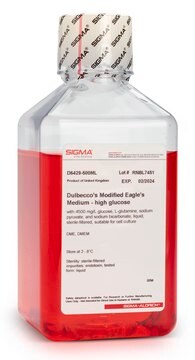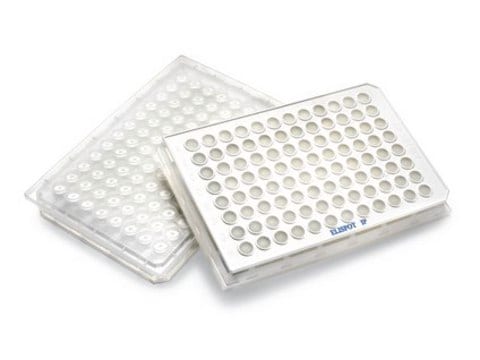SCC652
GLUTag Mouse Colonic Endocrine Cell Line

Synonym(s):
GLUTag, GLUTag cells, Murine GLUTag cells
Sign Into View Organizational & Contract Pricing
All Photos(2)
About This Item
UNSPSC Code:
41106514
Recommended Products
biological source
mouse
Quality Level
packaging
vial of ≥1 x 10^6 vial (viable cells per vial)
manufacturer/tradename
Millipore
technique(s)
cell culture | mammalian: suitable
shipped in
liquid nitrogen
storage temp.
−196°C
Application
- Each vial contains > 1X106 viable cells.
- Cells are tested negative for infectious diseases by a Mouse Essential CLEAR Panel by Charles River Animal Diagnostic Services.
- Cells are verified to be of mouse origin and negative for interspecies contamination from human, rat, Chinese hamster, Golden Syrian hamster, and nonhuman primate (NHP) as assessed by a Contamination Clear panel by Charles River Animal Diagnostic Services
- Cells are negative for mycoplasma contamination.
Features and Benefits
GLUTag cells are murine intestinal endocrine L-cells derived from colonic tumors. They secrete a variety of pro-glucagon derived peptides (PGDPs) such as GLI, IRG, and GLP-1. GLUTag cells are among one of the most widely used cell models to understand GLP-1 secretion.
Target description
Glucagon-like peptide-1 (GLP-1), an important regulator of glucose dependent insulin secretion, is a peptide hormone produced by enteroendocrine cells.2 It also plays a role in food intake and gut motility. GLP-1 activity is preserved in individuals with type 2 diabetes, allowing it to be an effective target for drugs to treat diabetes and obesity.
The GLUTag cell line is an effective intestinal endocrine L-cell model derived from colonic tumors of transgenic mice. This cell line secretes a variety of pro-glucagon derived peptides (PGDPs) such as GLI, IRG, and GLP-1.1 GLUTag cells are among one of the most widely used cell models to understand GLP-1 secretion. GLUTag cells are capable of activating GLP-1 secretion in vivo and have a phenotype that closely mirrors non-immortalized intestinal L-cells with some slight genetic differences. The immunoreactive profile of GLUTag cells also suggests L-cell lineage by being positively immunoreactive to GLP-1 and cholecystokinin, but negative for a large variety of other hormones such as calcitonin, insulin, and gastrin.
Although the GLUTag cell line has murine origins, they have been shown to have a relevant response mechanism that essentially mirrors the GLP-1 secretion response in humans. This means that testing potential therapeutic agents using GLUTag cells has been shown to still have a strong relevance to a human model. The ease-of-use of GLUTag cells becomes quite invaluable when compared to the difficulties of using primary human L-cells.
Source
Derived from an endocrine carcinoma in a mouse expressing SV40 Large T antigen. Fragments of the tumors were subcutaneously propagated in nude mice and individual cells from one of the tumors was isolated and single-cell cloned.
References
1. Drucker DJ, Jin T, Sylvia L, Young TA, Brubaker PL. 1994. Activation of proglucagon gene transcription by protein kinase-A in a novel mouse enteroendocrine cell line. Molecular Endocrinology. 8(12):1646–1655.
2. Kuhre RE, Wewer Albrechtsen NJ, Deacon CF, Balk-Møller E, Rehfeld JF, Reimann F, Gribble FM, Holst JJ. 2016. Peptide production and secretion in GLUTag, NCI-H716, and STC-1 cells: a comparison to native L-cells. Journal of Molecular Endocrinology. 56(3):201–211.
The GLUTag cell line is an effective intestinal endocrine L-cell model derived from colonic tumors of transgenic mice. This cell line secretes a variety of pro-glucagon derived peptides (PGDPs) such as GLI, IRG, and GLP-1.1 GLUTag cells are among one of the most widely used cell models to understand GLP-1 secretion. GLUTag cells are capable of activating GLP-1 secretion in vivo and have a phenotype that closely mirrors non-immortalized intestinal L-cells with some slight genetic differences. The immunoreactive profile of GLUTag cells also suggests L-cell lineage by being positively immunoreactive to GLP-1 and cholecystokinin, but negative for a large variety of other hormones such as calcitonin, insulin, and gastrin.
Although the GLUTag cell line has murine origins, they have been shown to have a relevant response mechanism that essentially mirrors the GLP-1 secretion response in humans. This means that testing potential therapeutic agents using GLUTag cells has been shown to still have a strong relevance to a human model. The ease-of-use of GLUTag cells becomes quite invaluable when compared to the difficulties of using primary human L-cells.
Source
Derived from an endocrine carcinoma in a mouse expressing SV40 Large T antigen. Fragments of the tumors were subcutaneously propagated in nude mice and individual cells from one of the tumors was isolated and single-cell cloned.
References
1. Drucker DJ, Jin T, Sylvia L, Young TA, Brubaker PL. 1994. Activation of proglucagon gene transcription by protein kinase-A in a novel mouse enteroendocrine cell line. Molecular Endocrinology. 8(12):1646–1655.
2. Kuhre RE, Wewer Albrechtsen NJ, Deacon CF, Balk-Møller E, Rehfeld JF, Reimann F, Gribble FM, Holst JJ. 2016. Peptide production and secretion in GLUTag, NCI-H716, and STC-1 cells: a comparison to native L-cells. Journal of Molecular Endocrinology. 56(3):201–211.
Storage and Stability
GLUTag cells should be stored in liquid nitrogen. The cells can be cultured for at least 10 passages without significantly affecting cell marker expression and function.
Other Notes
This product is intended for sale and sold solely to academic institutions for internal academic research use per the terms of the “Academic Use Agreement” as detailed in the product documentation. For information regarding any other use, please contact licensing@milliporesigma.com.
Disclaimer
Unless otherwise stated in our catalog or other company documentation accompanying the product(s), our products are intended for research use only and are not to be used for any other purpose, which includes but is not limited to, unauthorized commercial uses, in vitro diagnostic uses, ex vivo or in vivo therapeutic uses or any type of consumption or application to humans or animals.
Storage Class Code
12 - Non Combustible Liquids
WGK
WGK 2
Flash Point(F)
Not applicable
Flash Point(C)
Not applicable
Certificates of Analysis (COA)
Search for Certificates of Analysis (COA) by entering the products Lot/Batch Number. Lot and Batch Numbers can be found on a product’s label following the words ‘Lot’ or ‘Batch’.
Already Own This Product?
Find documentation for the products that you have recently purchased in the Document Library.
Our team of scientists has experience in all areas of research including Life Science, Material Science, Chemical Synthesis, Chromatography, Analytical and many others.
Contact Technical Service








